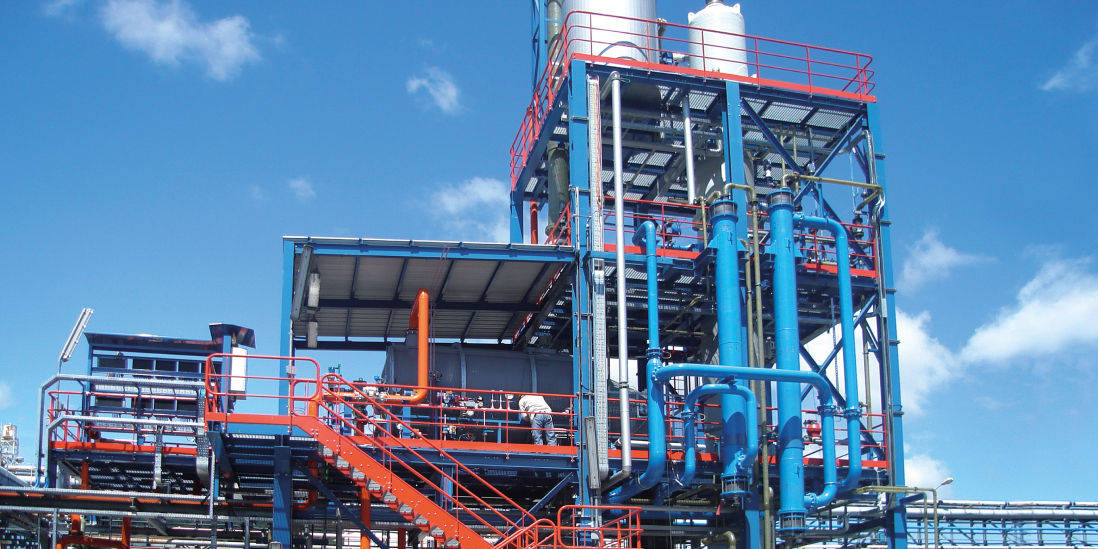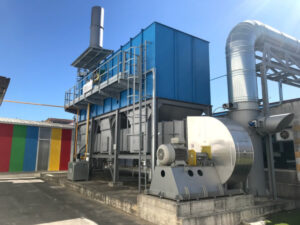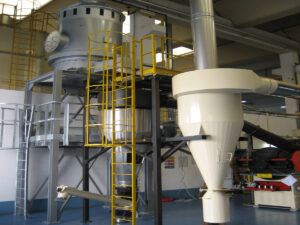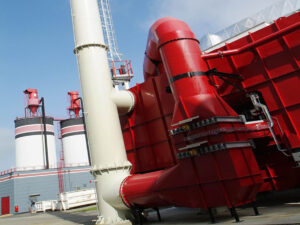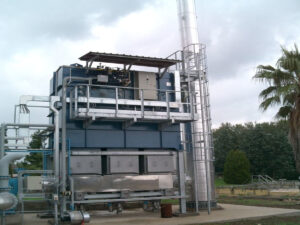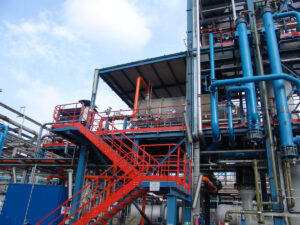Direct thermal oxidizers are designed to effectively destroy volatile organic compounds (VOCs) through a high-temperature oxidation process. Unlike other technologies, these systems don’t foresee heat recovery, ensuring an immediate and direct action to purify air.
Direct Thermal Oxidizers: features and advantages
- High depuration efficiency: > 99,9%.
- Compact design: reduced weight and dimensions
- Advanced control and remote management with PLC and remote assistance
- Modulating oxidation: it optimizes energy consumption according to the pollutants load
- Combustion chamber with insulating refractory materials for resistance and durability
- Turn-key solutions, tailor-made according to the Customer’s needs
Principle of operation of direct oxidizers
Polluted air is conveyed to a combustion chamber where – thanks to one or more burners –a temperature between 750°C and 950°C is maintained. This process ensures full oxidation of the pollutants, guaranteeing an abatement efficiency = 99,9%.
Thanks to their versatility, direct thermal oxidizers can be applied to different industrial sectors, when we need to treat effluents with high-concentration pollutants or to integrate complete oxidation processes.
The plant’s layout can be horizontal or vertical, adapting to installation conditions.
Main components of a direct oxidizer
- Burner: it keeps an adequate temperature ensuring pollutants’ destruction.
- Oxidation chamber: it ensures the necessary residence time for complete oxidation.
- Heat recovery (if any): it allows energy savings by reusing the thermal energy of the outlet effluent.
- Pre or post-treatment systems: to handle specific technical needs.
Basic parameters for dimensioning
To ensure maximum efficiency, the dimensioning of the plant considers:
- Flux speed
- Polluted air flowrate
- Operating temperature
- Turbulence
- Residence time in the oxidation chamber
BrofindⓇ equips its direct thermal oxidizers with advanced control systems, for a simple, intuitive management without the need for complex staff training.
Thermal oxidizers with pre/post-treatment
To handle complex pollutants and to ensure the plant’s maximum efficiency, thermal oxidizers can be equipped with pre- and post-treatment systems.
✔ Pre-treatments
Pre-treatments are used to protect the oxidizer from pollutants that could jeopardize its operation, e.g. silicon organic compounds, inorganic acids, inorganic bases, aerosol and dust. Available solutions include:
- Cyclones
- Bags or cartridge filters
- Venturi and tower scrubbers
- Filtering panels
- Activated carbon adsorbers
- Filters for the removal of oily mists
✔ Post-treatments
Post-treatments are necessary when the effluent exiting the oxidizer needs further treatment to reduce specific undesired compounds, such as halogenated VOCs, sulfurates or siloxanes. Available technologies include:
- Quencher for rapid cooling
- Tower scrubbers, specifically designed for the abatement of acids and bases, ensuring the pollutants neutralization before the final discharge
- Selective abatement systems to reduce specific emissions, including deNOx systems to reduce nitrogen oxides (NOx) produced during the oxidation process.
DeNOx technologies include:
-
- SCR (Selective Catalytic Reduction) with the injection of reagents such as ammonia or urea using catalytic support
- SNCR (Selective Non-Catalytic Reduction) with the injection of reagents such as ammonia or urea
Thanks to these integrations, Brofind® oxidizers ensure high performances and maximum reliability even with complex and variable flows.
Electric thermal oxidizers – OxyTherm® eco2
Brofind® offers fully electric solutions, cutting the use of fossil fuels and ensuring:
✔ Zero CO2 emissions from the fuel
✔ High energy efficiency with heat recovery
✔ Compact dimensions and easy installation
✔ Reliability and reduced maintenance
Typical applications and target sectors
Direct thermal oxidizers can be applied to different industrial sectors needing effective treatment of polluted emissions, in processes generating high VOCs concentrations or dangerous organic compounds.
The main areas of application are:
- Chemical industry
- Pharmaceutical sector
- Painting and coating
- Rubber and plastic production
- Waste treatment
- Food industry
These systems are particularly effective in a variety of production environments, ensuring compliance with the most stringent environmental regulations and significant energy recovery.
Customized plant solutions
All Brofind® direct oxidizers can be customized and designed with dedicated plant solutions, such as:
- Development of pre-treatment sections for pollutants containing silicon (silanes, siloxanes) or for streams containing dust
- Implementation of special alloy exchangers for corrosive gases
- High concentration management system for high pollutant load applications
- Secondary heat recovery with dedicated energy-saving solutions
- Use of low-emission burners to minimize environmental impact (LowNOx)
